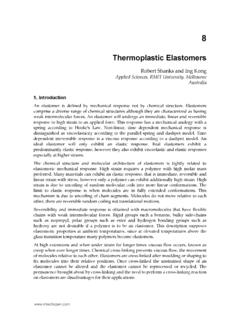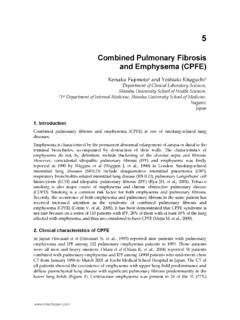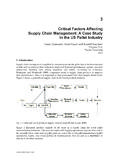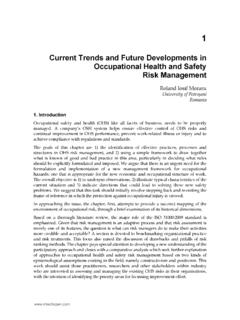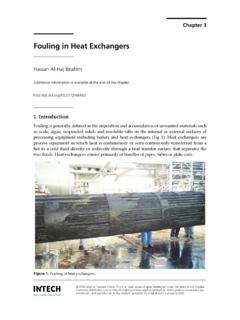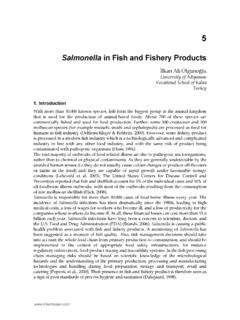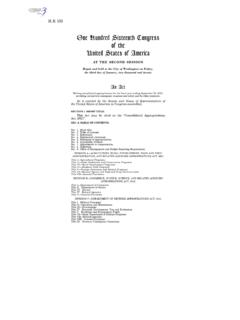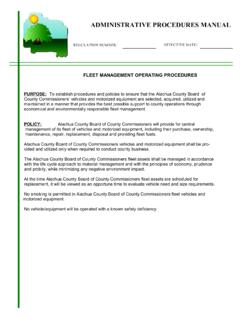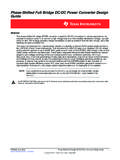Transcription of Biogas Plant Constructions - IntechOpen
1 17 Biogas Plant Constructions M. Samer Cairo University, Faculty of Agriculture, Department of Agricultural Engineering, Egypt 1. Introduction The chapter concerns with the Constructions of the commercial Biogas plants as well as the small and household units. Furthermore, the chapter aims at providing a clear description of the structures and Constructions of the anaerobic digesters and the used building materials. Ultimately, the chapter answers an important question: how to build a commercial Biogas Plant and a household unit, and what are the construction steps? 2. Chapter description and contents overview The chapter describes the construction steps and operation of Biogas Plant , which include: a.
2 Planning the Biogas Plant layout and designing the digesters, where the rules of thumb for planning the layout of a commercial Biogas Plant are elucidated and a methodology for specifying the dimensions of both digester(s) and residue storage tank(s) is illustrated, and they are: internal and external diameters of the tanks, wall thickness of the tank, height ..etc. b. Undertaking the project, carrying out the excavation (digging) works, preparation of the bottom plate of the digester, integrating the heating tubes, building the fermenter, installing the insulation, and technology installation. c. Running the Biogas Plant including the mechanization of the Biogas Plant such as: solids feeder, gas processing unit, mixing technology.
3 Etc. d. System control, how the individual facility components are monitored by computer technology even from afar as well as on-site using a computer system. 3. Overview Components of the Biogas unit The components of a Biogas unit are: 1. Reception tank 2. Digester or fermenter 3. Gas holder 4. Overflow tank Biogas 344 Size of Biogas unit The size of a Biogas unit depends on several factors, which are: 1. The amount and type of organic waste to be disposed in the digester 2. The objective of treating the organic waste (the production of energy and/or organic fertilizer) 3. Demand of natural gas and consumption pattern 4. On-site nature of the soil and the level of ground water 5. Air temperature in the region and wind direction throughout the different seasons 6.
4 The training level of the staff on farm and home regarding operation of Biogas units The amount of manure fed into a digester each day has an important effect on its operation. This is measured by volume added in relation to the volume of the digester, but the actual quantity fed to the digester also depends on the temperature at which the digester is maintained. In order to determine the unit size of a Biogas unit, the following mathematical equation must be achieved: Digester size (m ) = Daily feed-in (m day-1) Retention time (day) (1) The digester size can be defined as the total size of the Biogas unit, which includes the effective size of any volume occupied by the fermented material and the volume of gas storage.
5 Size of the daily feed-in is the size of a mixture of dung with water added to the digester once daily or several times and the average concentration of total solids of 10%, where mixing the organic wastes with water depends on its water content. In the case of wet animal wastes, such as manure the proportion of mixing is 1:1. Generally, Storage capacity has to be calculated by average live weight of animals kept in husbandry systems, amount of added water, periods of no fertilization of crops, and the animal species. In order to plan a Biogas Plant and to design a digester, several design parameters must be determined which are: ratio of gathered waste from manure canals to total waste, number of cows in farm, amount of manure produced by a cow which is usually m3 cow-1 month-1, quantity of daily liquid organic matter deposition into the digester, hydraulic retention time, density and quantity of daily dry organic matter deposition into the digester, and digester load which is usually 2-4 kg m-3 day-1.
6 The aforementioned design parameters are used to determine the total volume of the materials that are intended to be stored in the tank and are equal to the internal volume of the tank. Additionally, the designer should take into consideration that a part of the tank (about 10%) is empty and the substrates should not fill it, because it is the place where the gas will accumulate. Even in case of designing other storage tanks ( liquid organic matter tank) it is required to leave 10% of the tank volume empty. Types of digester During the last century a number of different types of flows in simple digester have been developed and they can be of the following kinds: (1) batch flow, (2) continuous flow, (3) continuously expanding, (4) plug flow, and (5) contact flow.
7 The conventional digesters are those utilized to process liquid raw materials with a high content in solids, also called rural digesters, the fermentation chamber having a volume below 100 m3. Conventional digesters Biogas Plant Constructions 345 are installed without any type of mechanism to reduce the retention time during which the biomass remains inside are predominant; these systems are fed discontinuously and known as discontinuous-flow batch digesters, or fed periodically and known as continuous-flow digesters. Batch digesters are loaded at once, maintained closed for a convenient period, and the organic matter is fermented and then unloaded at a later time. It is quite a simple system with small operational requirements.
8 Installation can be made in an anaerobic tank or in a series of tanks, depending on the Biogas demand, availability and amount of raw materials to be utilized. Batch flow is most suitable for dry organic matters (solid materials), solid vegetable waste. This type of biowastes is fed into the digester as a single batch. The digester is opened, digestate is removed to be used as biofertilizer and the new batch replaces the digestate. The tank is then resealed and ready for operation. Depending on the waste material and the operating temperature, a batch digester will slowly start producing Biogas and increase the production with time and then drop-off after 4 to 8 weeks.
9 Batch digesters are therefore best operated in groups, so that at least one digester is always producing Biogas . Continuous digesters are usually requiring daily loading and residue management. The process is referred to as continuous since to every daily load corresponds a similar volume load of fermented material. The biomass inside the digester moves through by the difference in hydraulic heat, between the substrate entering the digester and the digestate coming out when unloading. Each load requires a retention time, usually between 14 to 40 days. Continuous digesters can have their retention period reduced by the introduction of agitation and heating. The disadvantage of these models is that the raw material needs to be diluted.
10 The great advantage of these digesters over the batch type is that a single unit allows a continuous supply of Biogas and biofertilizer and the continuous treatment of small amounts of waste (Florentino, 2003). Biogas production can be accelerated by continuously feeding the digester with small amounts of waste daily. If such a continuous feeding system is used, then it is essential to ensure that the digester is large enough to hold all the material that will be fed into the digester in the whole digestion cycle. One key issue is to implement two digesters, accomplishing the biodegradation of the organic waste through two stages, with the main part of the Biogas is being produced in the first stage and the second stage serves as finishing stage of the digestion at a slower rate.


